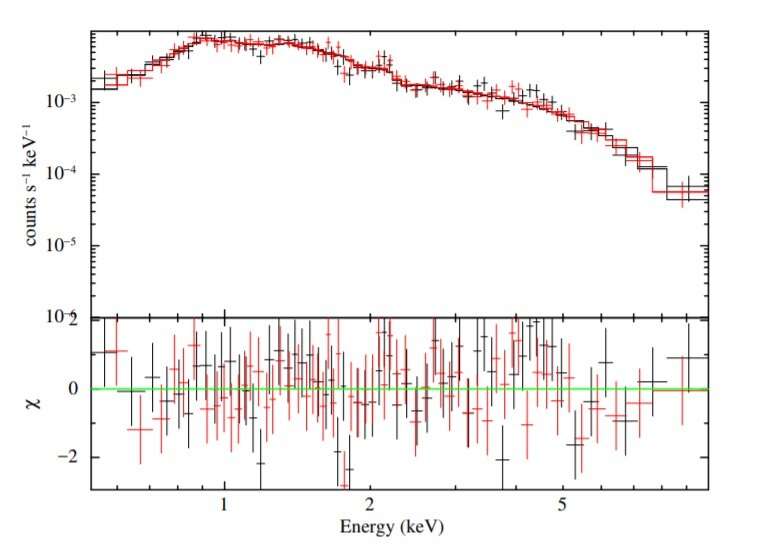New energetic pulsar discovered in the Small Magellanic Cloud

Using ESA’s XMM-Newton spacecraft, an international team of astronomers has detected a new energetic rotation-powered pulsar in the Small Magellanic Cloud (SMC). The newly found pulsar, designated PSR J0058–7218, appears to be the most energetic pulsar so far discovered in the SMC. The finding is detailed in a paper published May 17.
Pulsars are highly magnetized, rotating neutron stars emitting a beam of electromagnetic radiation. They are usually detected in the form of short bursts of radio emission, however some of them are also observed using optical, X-ray and gamma-ray telescopes.
At a distance of about 195,000 light years away, SMC is a gas-rich irregular galaxy orbiting the Milky Way. To date, dozens of pulsars have been detected in SMC, but only a few of them are young energetic rotation-powered ones.
Ideal places to search for this type of pulsars are supernova remnant (SNR) – pulsar wind nebula (PWN) composites. One of them is IKT 16—a large X-ray and radio-faint SNR, in which a central source of hard X-ray emission was identified using XMM-Newton.
Now, a team of astronomers led by Chandreyee Maitra of the Max Planck Institute for Extraterrestrial Physics in Garching, Germany, has investigated this source with XMM-Newton and found that it exhibits pulsations, what confirms its pulsar nature.
“IKT16 was observed with the European Photon Imaging Camera (EPIC) on board the XMM-Newton satellite starting on 2020 March 15 for an orbit (Obsid 0841450101). We report here the discovery of pulsations from the central source in IKT 16 (PSR J0058−7218 from now), confirming its nature as an energetic rotation-powered pulsar,” the researchers explained.
According to the paper, PSR J0058–7218 has a spin period of about 21.77 milliseconds, spin period derivative at a level of 0.029 picoseconds/second, and characteristic age of 12,000 years. Therefore, these parameters suggest that it is a young rotation-powered pulsar.
The spin-down luminosity of PSR J0058–7218 was estimated to be approximately 110 undecillion erg/s. The astronomers noted that this value indicates that this object is a Crab-like pulsar and the most energetic pulsar so far detected in the SMC.
The surface dipole magnetic field of PSR J0058–7218 was measured to be at a level of 800 billion G. The study also found that the pulsar has an X-ray luminosity of approximately 120 decillion erg/s.
In concluding remarks, the researchers noted that PSR J0058–7218 is a young, energetic and ultra-fast pulsar, emphasizing the importance of the detection of this object for pulsar studies.
“The discovery of a young, energetic and ultra-fast pulsar like PSR J0058–7218 provides a unique opportunity to probe the braking mechanisms and birth-spin models of rotation-powered pulsars. Future monitoring of PSR J0058–7218 is crucial to constrain the second derivative of the period in order to measure the braking index of the pulsar and allow deeper searches in the radio and gamma-rays, and look for putative glitches that are fairly common in young rotation-powered pulsars on timescales of a few years. A continuous monitoring of the spin evolution will also be very important because of its potential as a source of detectable gravitational waves,” the authors of the paper concluded.



 Creators of mankind
Creators of mankind Description of “Tall white aliens”
Description of “Tall white aliens” Where they came from?
Where they came from? About hostile civilizations
About hostile civilizations The war for the Earth
The war for the Earth “Tall white aliens” about eternal life
“Tall white aliens” about eternal life Video: “Nordic aliens”
Video: “Nordic aliens” Aliens
Aliens Alien encounters
Alien encounters The aliens base
The aliens base UFO
UFO Technology UFO
Technology UFO Underground civilization
Underground civilization Ancient alien artifacts
Ancient alien artifacts Military and UFO
Military and UFO Mysteries and hypotheses
Mysteries and hypotheses Scientific facts
Scientific facts


















